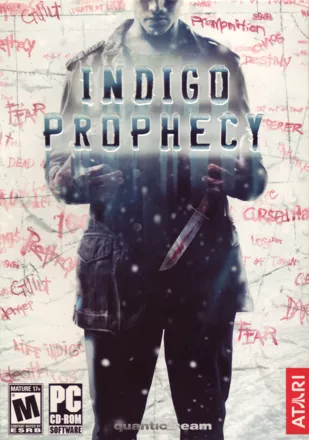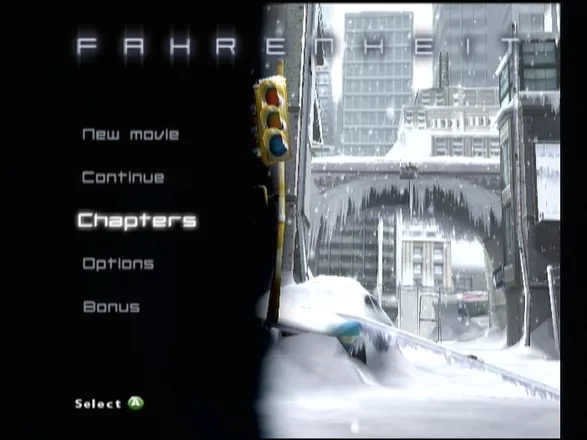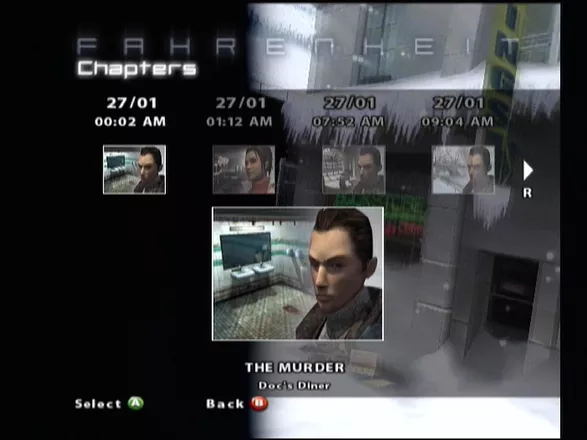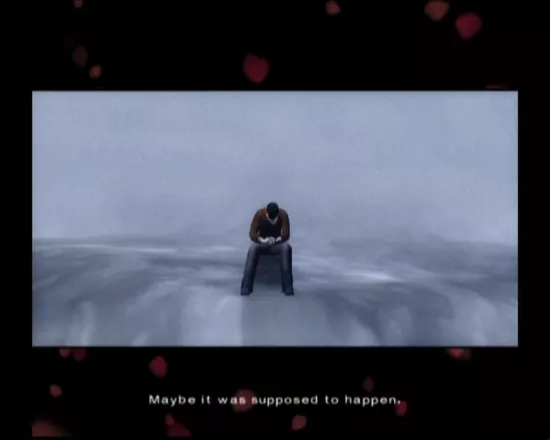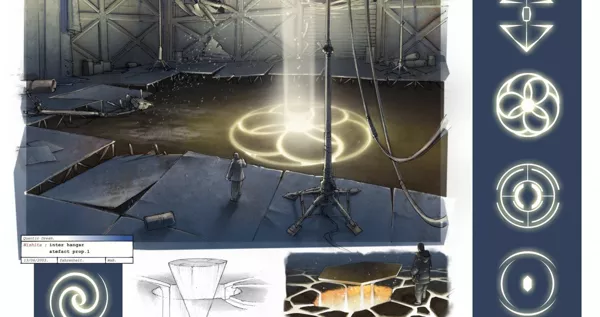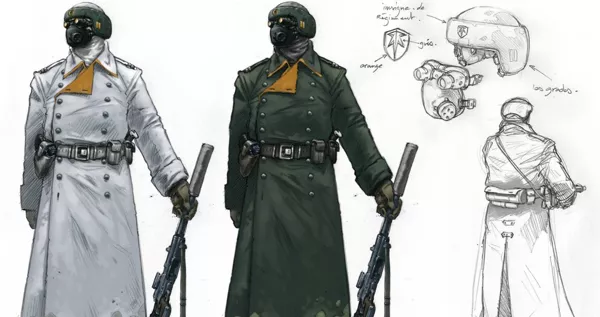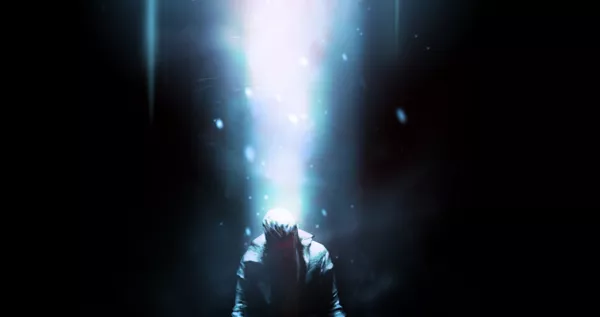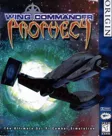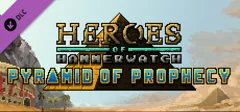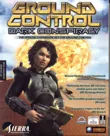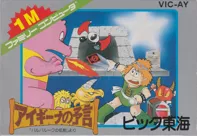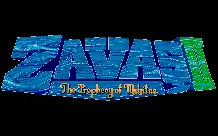Indigo Prophecy
Description official descriptions
January 2009. On a cold, snowy night in New York City, an ordinary citizen named Lucas Kane, under the control of an unknown force, unwillingly murders a complete stranger in a diner. Once he comes to senses, Lucas realizes he must escape while leaving as little evidence as possible behind. Barely managing to accomplish that, Lucas contacts his brother and tries to understand what has caused him to commit the crime, recalling the events of his own past in the process. Meanwhile, two police detectives investigating the murder, Carla Valenti and Tyler Miles, are determined to find the perpetrator, at the same time trying to deal with the personal problems of their lives.
Indigo Prophecy (Fahrenheit in Europe) is a psychological thriller in which the player is able to control different characters on both sides of a murder - the killer and those who are trying to find him. The game's core gameplay style is adventure. The three protagonists explore various locations, talk to other characters, and interact with the environment in order to advance. However, the game is heavy on various action-oriented sequences, from tasks that must be completed within a limited amount of time to quick time events, which require the player to press the correct button during a scene.
The game emphasizes realism in the player's interaction with the environment. For example, picking up a rag and cleaning the floor requires the player to move the mouse or the analog stick back and forth, imitating the actual movements of the object. Dialogue with character often imposes time limits on the player; failure to choose the optimal response in time will prompt the game to choose another, not always the optimal one. The player's choice will sometimes influence the subsequent events and the outcome of the entire story, eventually leading it to one of the three possible endings.
Cinematic treatment is evident in the game's handling of action-based gameplay and cutscenes, which are often seamlessly integrated into each other. An example of this is the split-screen technique, which is often used during the game's most dramatic moments: while the player is trying to complete the required action in time on one screen, another one displays what is happening around the controlled character.
Spellings
- 全面失控 - Traditional Chinese spelling
- 靛青预言 - Simplified Chinese spelling
- 인디고 프로페시 - Korean spelling
Groups +
- Best of Infogrames / Atari releases
- Gameplay feature: "Simon says"
- Gameplay feature: Multiple endings
- Indigo Prophecy / Fahrenheit games
- Nudity
- PC Gamer Presents games
- Protagonist: Hunter & Hunted
- Setting: City - New York
- Setting: Future now past
- Software Pyramide releases
- Technology: amBX
- Theme: Law enforcement
Screenshots
Promos
Videos
Add Trailer or Gameplay Video +1 point
See any errors or missing info for this game?
You can submit a correction, contribute trivia, add to a game group, add a related site or alternate title.
Credits (Windows version)
192 People (189 developers, 3 thanks) · View all
| Director | |
| Executive Producer | |
| Assistant Project Manager | |
| Production Assistant | |
| Engine Manager | |
| Platform Managers | |
| 3D Engine | |
| Tools Manager | |
| Tools | |
| Design | |
| Graphic Manager | |
| Lead Characters | |
| Senior Artist | |
| [ full credits ] | |
Reviews
Critics
Average score: 84% (based on 96 ratings)
Players
Average score: 3.8 out of 5 (based on 212 ratings with 15 reviews)
The Good
Fahrenheit (Indigo Prophecy in the US) was made by Quantic Dream, the same company that created Nomad Soul, a very original game with plenty of creative content. I was interested to discover that the next product of the talented developers turned out to be an intriguing attempt to reinvent the adventure genre - sadly, a rather unsuccessful one.
The passion of the developers and their belief in the design ideology they express through the game mechanics is instantly noticeable and commendable. Essentially, Fahrenheit tries to solve the "adventure problem". Since the prolonged agony of adventure games has begun, various developers started looking for the cure. One of the most common recipes was inclusion of action elements and reduction of puzzle-solving. The example of Dreamfall, however, showed that was a clear dead end. Fahrenheit opts for a more fundamental change: it revives the old concept of an "interactive movie" and imbues it with consistent action. Most true interactive movies (like Tender Loving Care) failed because they were reduced to watching long cutscenes while occasionally making a choice. This was also more or less how Japanese adventures worked, although they were more "interactive novels" than movies.
Fahrenheit is also an "interactive movie", and that is its conscious, deliberate self-definition: even on the main screen, there is a "New Movie" option instead of "New Game". But from the very beginning you are thrown into a suspenseful segment where gameplay is integrated into the movie. Essentially, you are invited to actively participate in cutscenes. Fahrenheit does draw from concepts introduced by earlier games, such as the (ill-)famed quick-time events from Shenmue. I have to say that this game takes them more seriously and their implementation is somewhat more exciting thanks to the superior quality of dramatic direction. There are also bits of more traditional interaction here and there, spiced with an interesting physical element that requires fiddling around with your mouse.
The game's cinematic merits are unquestionable. There is the dramatic split screen, where one of the sections shows your character, while the other displays what is happening around him. This seemingly simple feature works great (especially in the beginning) creating a tense atmosphere. Imagine you are trying to run away before the police arrives and actually see the policemen approaching while you are moving. Motion capture is beyond reproach, and the direction of some of the cutscenes is quite impressive.
Fahrenheit starts strong. Right away, you are invited to what is probably the best sequence in the entire game - a suspenseful introduction to most of its gimmicks done in a concise, poignant fashion. In particular, the enigmatic story keeps you on the edge of your seat - until it collapses under its own pretentious, nonsensical conclusion.
The Bad
I guess you've already heard about the disappointing ending of Fahrenheit and how its story goes downhill halfway through. To be fair, I think it would be extremely hard to come up with a reasonable explanation for the whole mystery; perhaps in one way or another, the solution was bound to be a disappointment. But I feel that there was still no need to resort to such obvious, painful cliches. I can't reveal much for fear of spoiling the story, but let's just say that if you've seen the ending of this game the infamous amnesia twist from Final Fantasy VIII doesn't seem that bad anymore.
Much bigger problems, however, lie with the gameplay. QTEs must have some drug-like qualities, because it seems that developers become addicted to them the more they use them. I'd be okay with a few well-placed quick-time events (though by no means thrilled by them), but this game ends up being full of them, and they don't really make sense. They get trite and tiresome even in all those action-loaded scenes, during chases and fights; but it's particularly weird to press buttons while watching a totally peaceful scene without any action at all. I recall a scene which showed the Oracle talking to the members of the Orange Clan; during this conversation, I had to press buttons. For what? The Oracle is not one of the playable characters, nor are the clan members. Was I pressing buttons to help the Oracle? Or to bother him?
I felt that the developers loved their own concept too much. That is probably the game's most unsettling message. Fahrenheit is all about relentlessly pursuing its creator's gimmicky ideas, imposing and enforcing them on any solid gameplay concept until there is none left. After all, what have we seen here? A lot of cutscenes, excessive QTEs, and a nice, but shy and shallow adventure game in fancy clothes that reveals itself as disappointingly simplistic and easy once the novelty of suspenseful game-and-film synchronization wears off. There are no interesting puzzles and hardly any exploration, which is a recipe for a dull on-rails adventure game masquerading itself as a "meaningful" action title. Designing a game by creating a movie and then applying a few smart tricks to make it more playable and exciting is neither revolutionary nor promising for the future.
The Bottom Line
One may certainly admire the dedication with which this game was made, and it does have some neat ideas helping to emphasize its uncompromisingly cinematic nature. However, even if it had a better story to match its filmmaking aspirations, Fahrenheit would remain a timid, restricted adventure game clearly unable to revitalize the genre.
Windows · by Unicorn Lynx (181775) · 2017
Probably one of the best games out there...
The Good
One of the most impressive features of the game is its cinema-style presentation. You can basically shape the story based on the choices you make. Although the story itself deviates a little by your choices, it is still a great feature.
Personally, I was very impressed with this game when it first came out. I had very low expectations of this game at first since I really didn’t quite understand what all the fuss was about. After playing the first 10 minutes, I was blown away. I couldn’t believe how great the game was and I couldn’t stop playing it.
The game unfolds like a movie. So explaining the game mechanics is hard to explain without spoiling much of the fun. In other words, the game must be experienced, not heard about.
If I remembered correctly, you can play three different characters; with each character’s story intertwining each other.
The Bad
There are four things I really didn’t like in this game.
The first is the stress system. I don’t know if it’s actually called the stress system, but I think the name is appropriate. The stress system is basically your mental state throughout the game. Depending on what dialogue choices you make, actions you take, and things you see, your stress level can increase or decrease. If you’re happy and alert, you can handle certain things; however, if your stress level is very high, the game can end if you pick the wrong choices. For example, listening to music can make your stress level reduced. However, if you watch news reports about yourself, your stress can increase. If you are so stressed out, and you happen to do something that furthers increase your stress, the game ends.
The stress system is great, in my opinion. However, the problem with it involves what can increase and decrease your stress level. The game isn’t exactly clear on it and sometimes if your stress is really high, and the next scene involves your stress level increasing, your game can end.
The next thing I really didn’t like is the “plot twist.” Of course I won’t spoil it for anyone, but I think everyone who played the game thought to themselves, “Where the heck did that come from?!?!” The plot twist is really out of place and nothing seems to build upon it from previous dialogues and scenes. It made it appear as if the developers had an original story, then somewhere along the line they decided to throw in this plot twist without any time to fit it around the earlier scenes.
The next thing I really didn’t like was the interaction within the game. The game plays a bit of a “Simon Says,” where you have to move your left and right analog sticks according to what’s given on the screen. It’s alright, but it presents no challenge to the game. Basically, the two sure ways you can die in this game is by the stress level or missing a sequence to this “Simon Says” thing.
The final thing I didn’t like was the game’s length. The game was very short compared to other games. I think the game itself can be played in 4-6 hours.
The Bottom Line
I recommend this game to anyone who wants an interesting story, and a fantastic game. The game is very hard to explain in words and it’s best to just go out and play the game.
PlayStation 2 · by Daniel Allen (13) · 2007
The Good
+The overall design, atmosphere, and gameplay is unique, plus it really does stand out from the crowd. It’s one big, satisfying interactive movie with a compelling, twisting story that allows you to “bend” the situations.
+An excellent music score that sets the mood and goes well with the widescreen format of the game.
+Interesting, well-voiced characters with great dialogue.
+Exciting action-sequences and tasks that requires the use of the analog sticks and shoulder buttons.
+Multiple endings based on your actions and an auto-save feature for all chapters which allows you to start where you want to change your previous decisions.
+Character models aren’t the greatest but they are utilized effectively for evoking emotion from the player (that means me...I guess).
The Bad
-Becomes quite strange and rushed in the last-half of the game. A big shame because if more care had been implemented as the first half had, this would’ve been the greatest.
-Needed to be longer (this goes along with the first negative).
The Bottom Line
Indigo Prophecy is not a perfect experiment but it shows how so many games under-utilize the capabilities of a video game to evoke emotion or tell a story. In a market full of the same-old FPS’s and action games, IP stands above the rest. I pray that other developers will look to this game and its positive elements. Oh yeah, this game is a worthy addition to your collection...PERIOD!!!
PlayStation 2 · by Ocram (7) · 2007
Discussion
| Subject | By | Date |
|---|---|---|
| Skipping cutscenes | DreinIX (10446) | Sep 25, 2009 |
Trivia
1001 Video Games
Fahrenheit appears in the book 1001 Video Games You Must Play Before You Die by General Editor Tony Mott.
Cut Content
In the U.S. version, the sex scenes have been toned down to maintain a Mature rating.
Development
- Fahrenheit was first announced as an episodic game. With this business model, Quantic Dream wanted to sell the game at a budget price, and then release monthly episodes and half-yearly bundles. This concept allowed for cliff-hangers, red herrings, mysteries, and surprises, with a new build-up in hype every month. Ultimately, they did not go along with it and released the game as a whole, at a regular price.
- The game was in development for five years - two years to create the tools and engine, two years to develop the game, and an additional year to sell it to the publisher.
Genre
The developers themselves do not call the game an adventure, but rather interactive drama, a story that is evolving according to the player's choices in the game, where gameplay is the story. It consists of bending stories, with a beginning, a middle and an end, but everything in between can be stretched or has multiple paths.
Publishing
The game was first to be published by Vivendi Universal, but developer and publisher parted ways in November 2004 because of differences in creative vision.
References
- Early in the game when the player wakes up as Tyler there is a desk in the bedroom with an action figure on it that when checked says: "This is a figurine of Sox, a character from my favorite videogame." Sox is a robot from another Quantic Dream game, Omikron: The Nomad Soul.
- At one point of the game there's also news about Omikron on the Internet. It can be accessed from Tyler's computer at the police station. Notice also how much the archive computer in the basement of the police station looks like a Commodore VIC-20.
- The concept of an Indigo Child is an actual theory, though not quite the same as the game presents it.
Technology
The game contains thirteen hours of full body and facial animation, which, according to the developers, has never been done in a video game, a TV series, or a film.
Tutorial
In the tutorial, the player is introduced to the game in a training room by director David Cage, not just with a voice-over, but using a rendered model as well. He also briefly discusses his creative vision.
U.S. Title
The decision to rename the game Indigo Prophecy in the U.S. was made by Atari. Fahrenheit suggests September 11th because of Michael Moore's critical film Fahrenheit 9/11, even though it's equally well known as a temperature scale, or in reference to Ray Bradbury's book Fahrenheit 451.
Awards
- 4Players
- 2005 – Best Adventure of the Year
- 2005 – Best Innovations of the Year
- GameSpy
- 2005 – PC Adventure Game of the Year
- 2005 – PC Adventure Game of the Year (Readers' Vote)
- Golden Joystick Awards
- 2005 - Unsung Hero of the Year* PC Powerplay (Germany)
- Issue 04/2006 - #2 RPG/Adventure in 2005 (Readers' Vote)
- Issue 02/2006 - Most Innovative Adventure in 2005
Information also contributed by Jeanne, Mr. Sefe, piltdown man and Zack Green.
Analytics
Upgrade to MobyPro to view research rankings!
Related Sites +
-
Developer's diary
An extensive post-mortem by director David Cage. -
FAQs and Guides
on GameFaqs.com -
Fahrenheit
Official Web Site -
UHS Hints for Indigo Prophecy
Nudges you along so you can try to solve the game yourself. Given in question and answer format. Includes full solutions. -
Walkthrough by Grawl
posted on GamesOver -
Zarf's Mini-Review
A mini-review of the PlayStation 2 version of Indigo Prophecy by Interactive Fiction developer Andrew Plotkin (June, 2006).
Identifiers +
Contribute
Are you familiar with this game? Help document and preserve this entry in video game history! If your contribution is approved, you will earn points and be credited as a contributor.
Contributors to this Entry
Game added by Jeanne.
PlayStation 4 added by Sciere. Xbox 360 added by Parf.
Additional contributors: Unicorn Lynx, Sciere, Zeppin, Paulus18950, Patrick Bregger, Rik Hideto, FatherJack.
Game added September 20, 2005. Last modified February 23, 2024.
